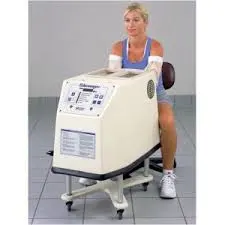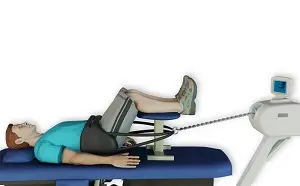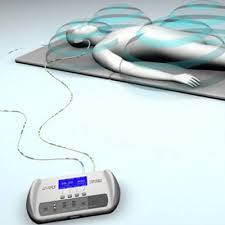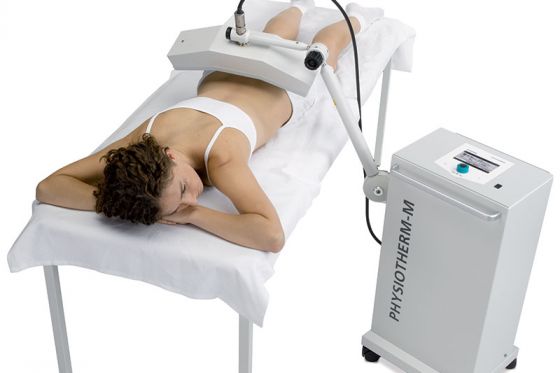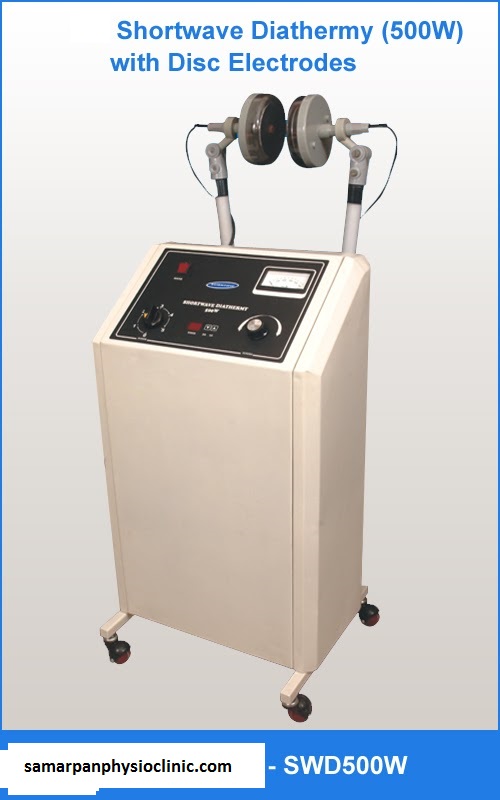Fluidotherapy
Fluidotherapy is a therapeutic modality used in physical therapy and rehabilitation settings. It involves the use of a specially designed machine to create a dry thermal airflow, which is combined with cellulose particles (such as finely ground corn husks) to create a fluid-like medium. Patients place their affected body part, such as hands, feet, or limbs, into the fluidotherapy machine for treatment.
During the treatment, the dry thermal air and cellulose particles surround the affected body part, creating a massaging and warming sensation. The temperature of the fluidotherapy can be adjusted according to the patient’s needs and tolerance.
A dry whirlpool of finely split solid particles floating in a heated air stream, with the mixture having the qualities of a liquid, is what makes up the high-intensity heat technique known as fluid therapy. It offers tactile stimulation in addition to surface heat and permits an active range of motion.
Studies that compared its heating effectiveness to that of a paraffin bath and whirlpool discovered that they were comparable. Fluid therapy is useful in treating acute or subacute traumatic or non-traumatic musculoskeletal problems of the extremities because it reduces pain, oedema, and muscle spasm. Injured or arthritic hands and wrists have been shown to benefit from an improvement in range of motion as well as a decrease in pain and stiffness.
Table of Contents
What is Fluidotherapy?
A dry heat method that uses forced convection to transfer energy is fluid therapy, often known as dry heat treatment. When heated air and cellulose particles are forcedly moved around the body part being treated in the machine’s chamber, heat is transferred. This process is known as forced convection. Air is driven through the solid particles, which causes them to become suspended
Heat, massage, and fluidized particles all work together to promote a range of motion, improve blood flow, and reduce inflammation.
The characteristics of fluid therapy are comparable to those of a dry whirlpool or a whirlpool devoid of water. According to the patient’s tolerance, the temperature and agitation can be changed. Although it may be lowered to room temperature, the working temperature is typically between 100 and 125 degrees. The average length of treatment is 15 to 30 minutes.
Hypersensitive regions can be desensitized using varying levels of stimulation. While receiving fluid therapy, patients can move the affected body part through the particles and carry out exercises.
Equipment:
- The apparatus consists of a cabinet containing cellulose manufactured from maize cob that has been finely pulverized.
- The particles flow like a liquid as a result of the device’s circulation of hot air through them.
- More heating is possible with it than with water or paraffin treatments.
- The apparatus uses an electric fan housed inside a steel cabinet with a top to circulate a stream of thermostatically regulated hot air over and through the particles.
Patient Preparation:
- The patient should undress the afflicted region and take off any jewellery or other objects that could get in the way of the therapy, just as they would for using a hot pack.
- Prior to therapy, the therapist should assess the patient for heat and cold sensitivity in the skin.
- To stop additional harm or contamination, the area that has to be treated must be covered with a plastic sheet if there is an open wound present.
Application:
The patient opens the sleeve to stop particles from escaping and extends the portion that has to be treated via the unit’s portal. The patient is instructed to exercise the portion within the cabinet while the proper temperature is kept in place. The unit is kept at a temperature of 38 to 45 °C, preferably a bit higher. Typically, the procedure takes 15 to 20 minutes.
Benefits of Fluidotherapy:
Fluid therapy may help with:
- Reduction of pain and inflammation
- Decrease in joint stiffness
- Extension of range of motion Reduction of muscular spasm
- Enhancing tissue repair
- Increasing the area’s supply of nutrients and blood
- Acute to subacute and traumatic or non-traumatic musculoskeletal disorders of the extremities might be the diagnosis.
- Heat treatment is compatible with physical activity.
- There is hardly any pressure applied to the treated area.
- Heat treatment is simple to use.
- Provides heat that is pleasant and dry.
Fluid therapy is a suitable substitute for various other heat therapy methods since it is comparable to paraffin baths, whirlpools, and moist heat packs. The objective of applying heat is to alter the soft tissue’s core temperature and skin temperature in order to alleviate specific disorders’ symptoms.
Fluid therapy is more resistant to bacterial development due to its dry environment.
Heat eases tense muscles during rest and aids in loosening painful knots because it increases tissue flexibility. It can calm aching, irritated nerve endings. By accelerating your normal metabolic rate, it speeds up the healing process.
Disadvantages of Fluidotherapy:
- The equipment is really expensive.
- Oedema may get worse if the limb is kept in a dependent posture.
- The apparatus may lead to tissue burning and overheating.
- Some people are unable to tolerate the equipment’s inside particles.
- On a smooth floor, the particles may spill, making the surface slick and raising the possibility of falls.
What is treated by Fluidotherapy?
Numerous diagnoses can be treated with fluid therapy. It can heal ailments that affect you in:
- Elbow
- Wrist
- Hand
- Ankle
- Foot
Indication:
- Inflammation
- Following surgery, rehabilitation
- Subacute illness
- Persistent condition
Contraindication:
- Fever
- Anesthesia zone
- Severe vascular disease
- Hemorrhage
- Patients with heat sensitivity
Diagnoses comprise :
- Sprains/strains
- Following a fracture or dislocation, discomfort, and stiffness
- Inflammation and hypersensitivity after an injury or surgical scar
FAQs:
Fluid therapy is useful in treating acute or subacute traumatic or non-traumatic musculoskeletal problems of the extremities because it reduces pain, oedema, and muscle spasm. Injured or arthritic hands and wrists have been shown to benefit from an improvement in range of motion as well as a decrease in pain and stiffness.
Fluid therapy. This kind of superficial dry heat agitates particles near the afflicted extremities to provide a desensitizing effect. The temperature range is from 46.1 °C to 48.9 °C, or 115 °F to 120 °F. Technique: A container containing tiny cellulose particles is passed through with hot air.
The average length of treatment is 15 to 30 minutes. Hypersensitive regions can be desensitized using varying levels of stimulation. While receiving fluid therapy, patients can move the affected body part through the particles and carry out exercises.
Dry heat therapy reduces mild pain and stiffness related to non-rheumatoid arthritis by increasing the range of motion, decreasing localized discomfort, decreasing localized blood circulation, and relieving localized pain.
Localized pain relief
Treatment of non-rheumatoid arthritis patients with mild pain and stiffness
Intensify localized blood flow
When paired with exercise, joint range of motion management

